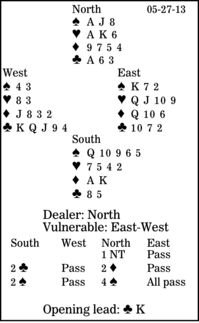Bridge column, May 27: How to describe major two-suiters

Let's start with one no-trump - two clubs (Stayman) - two diamonds (no four-card major) - two of a major. In pre-transfer days, a two-heart or two-spade rebid showed a five- or six-card suit and game-invitational values. Using major-suit transfers, Stayman followed by a two-heart rebid indicates a weak major two-suiter, in principle 5-5 (as was noted in the column on May 16). In contrast, rebidding two spades shows five spades, four hearts and game-invitational values -- see South's hand in today's diagram.
North, with such good major-suit holdings, raises to four spades.
How should South plan the play after West leads the club king?
The South hand has four potential losers: one spade, two hearts and one club. There are two ways to get home. First, win with dummy's club ace and play three rounds of hearts. Then, when back in his hand, declarer ruffs his last heart on the board.
Alternatively, South can play a dummy reversal. Suppose he ducks (loses) the first trick, and West shifts to a trump. Declarer finesses, East taking his king and returning a spade. South wins on the board, cashes the club ace, ruffs the last club, unblocks his top diamonds, and uses dummy's two heart entries to get two diamond ruffs. Declarer takes two spades, two hearts, two diamonds, one club and those three ruffs.
Yes, an initial trump lead is fatal, but that is hard for West to find.
** ** **
COPYRIGHT: 2013, UNITED FEATURE SYNDICATE
DISTRIBUTED BY UNIVERSAL UCLICK FOR UFS

